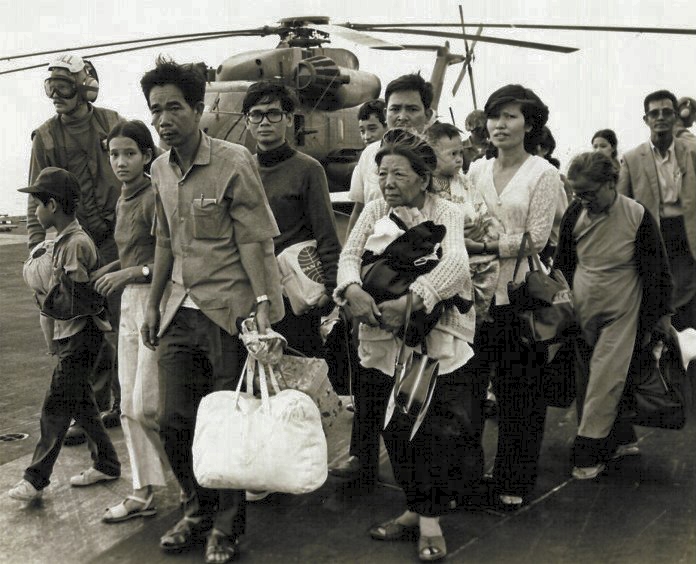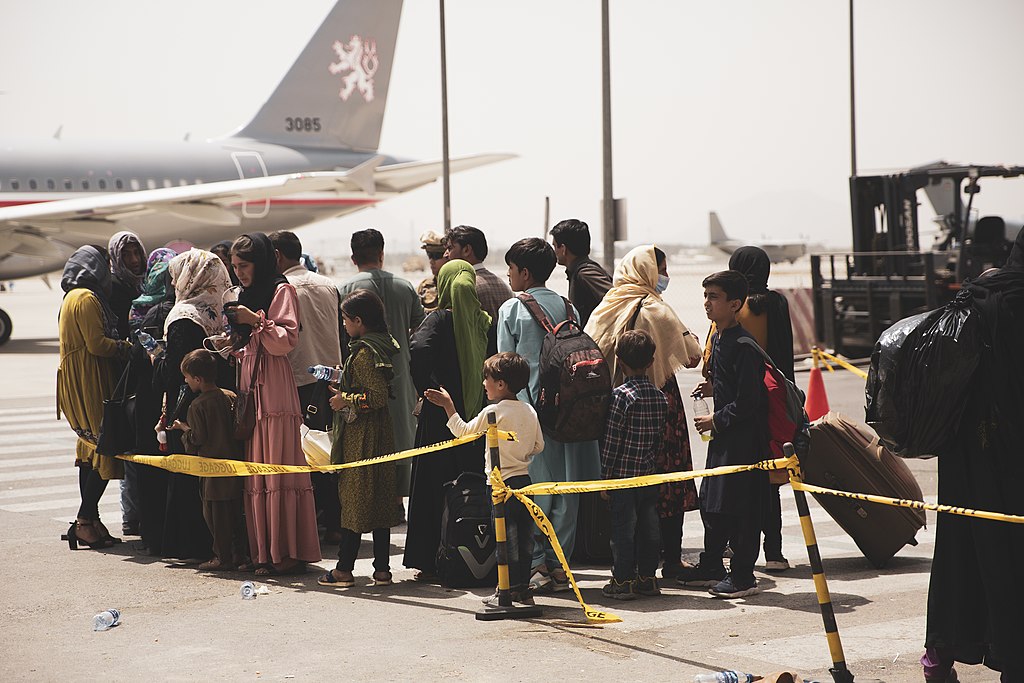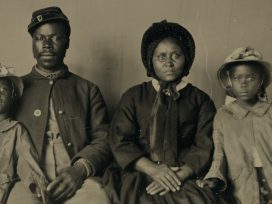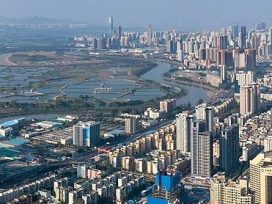Claire Potter: As the military situation in Afghanistan began to unspool at the end of July, and comparisons to the United States 1975 evacuation of Saigon proliferated, I wanted to know more. So I reached for Amanda Demmer’s After Saigon’s Fall: Refugees and US-Vietnamese Relations, 1975–2000 (2021) to think more deeply about the American defeat in Vietnam. Amanda, let’s begin with how your book challenges what we know about the end of the United States war in Vietnam.
Amanda Demmer: Most histories of the conflict produced in the United States end in 1975 with the fall of Saigon, a moment that is often treated as an epilogue to the removal of US troops in 1973. So 1975 is where I start. By ignoring the 20 years when the United States and Vietnam stood somewhere between war and peace, we miss key chapters of the Vietnam War itself. This leads to who and what issues matter. To understand those missing 20 years, you have to center not on war but refugee politics. Although the nation of South Vietnam no longer exists, the South Vietnamese people do. As migrants and activists, they play an influential role in international relations in those decades.

South Vietnamese refugees walk across a U.S. Navy vessel in 1975. Source Wikimedia commons
The quality of the ongoing United States withdrawal from Afghanistan has prompted many comparisons to the evacuation of Saigon in 1975. Is that appropriate?
The comparison is tempting, for so many reasons, partly because of the imagery that’s coming out of Afghanistan. There are mob scenes at the airport and United States aircraft hovering over buildings. These are unmistakable echoes of Vietnam, as is the reality of a quick and successful Taliban offensive leading to a rushed exit by Americans and their scrambled attempt to evacuate allies and panicked Afghan civilians.
But there are also many differences. In the case of the evacuation of South Vietnam, United States combat troops had left two years earlier under the terms of the Paris Peace Accords. In April 1975, there were still 6,000 Americans on the ground, but not combat troops, and the Republic of Vietnam was still functioning. In Afghanistan, we have seen the simultaneous withdrawal of remaining United States combat troops and the collapse of the Afghan regime they supported.
Another key difference is the contrast in media coverage. Americans saw the Vietnam war on the nightly news for years, and because the Fairness Doctrine was still in effect, whatever network they were watching, the coverage was pretty similar. With Afghanistan, the war has been going on for 20 years, but it has been largely invisible. I saw statistics on how much coverage the war received until this point on major outlets, and it was an average of about 26 minutes a year. So Americans have not been informed, the war has not been viscerally present, and the scenes at Hamid Karzai International airport are a shock.
There seems to be an expectation that the United States should take every Afghan who wants or needs to leave. Is that realistic?
AD: No, particularly given the numbers we’ve seen: I think the International Rescue Committee estimated that there were about 300,000 Afghans affiliated with the United States. Now that the Biden administration is using military and civilian aircraft, the evacuation has escalated, but there is a looming cutoff date of August 31st.
300,000 probably doesn’t include activists, journalists, and endangered scholars, artists, and intellectuals. Does it include families of allies?
My understanding is no, so it’s actually a much larger number. There will be individuals in Afghanistan affiliated with the United States who will be left behind, either for lack of documentation, geographic constraints, or not being able to get to the airport. The same thing happened in Vietnam. Many people who had a claim on or had received promises of American assistance were not evacuated in April 1975.
What happened to them?
When Hanoi was seeking to reunite the country, the government instituted a policy of reeducation. This was initially described as a 10 to 30-day process that would help military and civilian officials of the former regime become productive members of the new society. Some Vietnamese aligned with the North brought their own family members to reeducation, imagining it would be a brief moment of reorientation that supported a free, independent, and united Vietnam.
What actually happened is that reeducation was indefinite for many: the last detainees were not released until 1992. As a result, they endured harsh labor, mandatory confessions, little access to medical care, little contact with their families, and were often moved between various camps. At the time, human rights organizations compared the camps to gulags.
Now, not everyone in South Vietnam underwent reeducation, but probably around a million or so did, and it reverberated across society. Once people were released, they were monitored, and the state did not afford their children access to education or employment. Even if you were not interned but had a family member who was, it was an ongoing trauma.
Is that human rights catastrophe informing policymakers now?
Perhaps, but in a complex way. Because of the Vietnam war, the United States had little credibility regarding human rights in 1975. So one of the things that scholars have pointed to repeatedly is that resettling refugees allowed the United States to reclaim its reputation as a humanitarian nation, reframing itself as a nation that rescued refugees, not one that created them.
We see something similar in Afghanistan. Refugee resettlement may be a way for the United States to recover from the failures and human rights violations of the War on Terror. Continuing immigration programs past August 31, especially those that bring Afghans directly to the United States, is a way of doing that.
Of course, immigration is now a huge point of contention on the American right. But in your book, you point out that Americans were so overwhelmingly absorbed with the return of American POWs that they were not really paying attention to how many refugees were coming to the United States.
After 1975, there was a huge focus on missing American servicemen, aided by fictional accounts like Rambo. It becomes a highly visible political issue: the black POW-MIA flag is the only other banner beside the Stars and Stripes that has ever flown over the White House.
Americans were aware of refugee resettlement. But it was not front-page news because it happened over two decades, through different programs, and with bipartisan consensus. The evacuation of Afghan allies is at the forefront of news and politics now, but to the American public, that concern is still secondary to the successful evacuation of Americans. The Biden administration must be anticipating the political price, should all Americans not get out, but many Afghan allies do.
One of the things I see on social media and right-wing websites is: sure, get Afghan allies out, but don’t bring them here.
That tension existed in 1975 too. But the Ford administration foregrounded the idea of ‘internationalizing’ resettlement. They had some success at this: they sent some refugees to France, given its long historical ties with Vietnam. Others went to Australia. For the most part, however, the international community, especially in 1975, viewed refugees as an American responsibility. It was not until the so-called ‘boat people’ surged in 1978 and 1979 that major resettlement efforts took place elsewhere.
Younger readers might know what we mean by ‘boat people’. Can you explain?
Sure. Given Vietnam’s long coastline, leaving by boat was possible: in the four years between 1975 and 1979, I believe 300,000 Vietnamese left in this way. But it was hazardous. The vessels, which were going out onto an open ocean, were often unseaworthy. There were pirates, rainstorms and people who preyed on and sexually assaulted refugees.
Some of these migrants were forcibly expelled by the state, especially people of Chinese ancestry, when Vietnam and China were engaged in hostilities after 1975. Others were trying to flee, and rather than preventing it, the government extracted exorbitant bribes in return for letting them go.
So there was a wave of people flown out by the United States, and a second that left by boat. Then there was a third and prolonged wave of people who left under the family reunification provisions of United States immigration law.
When I was reading, I was thinking about the scenes at Kabul airport where people were handing their babies to Marines over the barbed wire. Is part of what is on the minds of parents some version of: ‘If my baby gets to the United States, then I can follow?’
I don’t feel comfortable speaking about the Afghan parents’ motivations. But I will say that in the Vietnam case, historian Allison Varzally argues that during Operation Babylift in April 1975, Vietnamese families did not view themselves as permanently surrendering their children, but rather securing their immediate safety, because it could not be guaranteed at home anymore. They did this hoping that they would be reunited with their children, but they also understood that they might not be. Concerning Afghanistan, I would guess there are similar impulses, but I can’t say for sure.

Civilians prepare to board a plane during an evacuation at Hamid Karzai International Airport, Kabul, Afghanistan, Aug. 18. U.S. Marine Corps photo via Wikimedia Commons
OK, to shift gears: one theme of your book is that we too often conflate human rights with humanitarianism. Can you talk about that?
There are separate entire sub-fields for the histories of human rights and humanitarianism. They are overlapping concerns, mostly through refugees themselves, but have their own unique origins and histories.
Humanitarianism is generally viewed as the impulse to assist others beyond the nation’s borders. Especially during the two World Wars, humanitarianism led to the growth of the Red Cross and other international organizations that help individuals abroad, not just during an armed conflict but after natural disasters.
The idea of international human rights is newer. It was first articulated in international law in the 1948 Universal Declaration of Human Rights, which established the idea that should a government violate its citizens’ human rights, there is an implicit obligation for other nations to speak up and intervene.
In the aftermath of the Vietnam war, the needs of South Vietnamese allies and American prisoners of war fell under the traditional umbrella of humanitarianism. But because the human rights movement exploded worldwide in the 1970s, it soon became linked to the cause of Vietnamese refugees. In the United States, this became a policy with the Refugee Act of 1980, which codified a human rights-based definition of ‘refugee’ and added a loophole to admit individuals who didn’t meet the definition but were of ‘special humanitarian concern’.
How have the linkages you describe affected popular and political pressure on the Biden administration to help Afghans fleeing the Taliban?
I think they have created a very large political tent where many people who usually have strong disagreements gather. Individuals who held divergent opinions about the war in Afghanistan are arguing together that the Biden administration must assist Afghan refugees.
One of the big differences between 1975 and today is a concern for women’s rights in a Taliban-dominated Afghanistan. In the immediate aftermath of the Vietnam war, we had not yet had global conferences about women, and feminism was only beginning to be a factor in American politics.
But to what extent is the focus on women, which we should all care deeply about, obscuring other kinds of human rights and humanitarian goals?
For proponents of traditional family values, the rhetoric about protecting women and children has a particular appeal. But to some extent, concern about women also musters the necessary consensus for resettling Afghan refugees more generally. It is also very different from the martial, ‘never leave a man behind’ rhetoric used in the past when talking about allies.
After hostilities have ended, but while antagonists are still engaged, is a phase of war you call ‘normalization’. Can you define that term for us? And how will the process of normalization that followed Vietnam inform United States–Afghanistan relations after 31 August 2021?
Normalization is generally synonymous with diplomatic recognition and a return to peaceful diplomatic and economic relations. In the case of Vietnam, after the evacuation in 1975, the United States refused to recognize the government in Hanoi, did not send an ambassador, did not afford Vietnam recognition in international arenas, and did not establish formal trade relations until the mid-1990s.
But, as I argue in the book, normalization is a process. If we take the moment when Bill Clinton awards diplomatic recognition in 1995 and say, okay, that’s the moment of normalization, we miss the 20-years that it took to achieve that. Between 1975 and 1995, negotiations on humanitarian issues – primarily migration programs and returning the remains of United States servicemen – became the mechanisms through which formal diplomatic relations were re-established. Even as the United States was implementing an embargo and leading an international effort to isolate Hanoi, officials from both nations were meeting at the United Nations in Geneva and Hanoi.
If any Americans were still on the ground after 31 August, that would be a top priority for the Biden administration. I don’t see any scenario in which the US government does not get all Americans out of Afghanistan one way or another. But I will not be surprised if we see, at least initially, a very similar approach to post-war Afghanistan. On the one hand, the Biden administration might condemn the Taliban and seek to withhold economic aid, not just from the United States but from institutions like the World Bank and the International Monetary Fund. So we may see a belligerent economic, diplomatic, and cultural tone, while at the same time, the United States may still work with the Taliban on behalf of Afghan allies.
Your book, I thought, had a happy ending, in which South Vietnamese communities in the United States organized on behalf of themselves and their families, becoming their own policymaking and humanitarian network and reconnecting to those who remained behind either by conviction or by force.
The phrase ‘happy ending’ makes me cringe a little. One of the things I stress in the book is that the costs of the loss in Vietnam are borne disproportionately by the South Vietnamese, particularly in family separation. Americans lose family members, but after 1975 most Americans thought of the war as past, whereas for the Vietnamese, it was in the present, and it’s an ongoing trauma to this day. In many cases, families did reunite due to their own lobbying. But I want to honour aloud the human cost of this: I don’t think it’s a happy ending.
Thanks for that correction, Amanda. So one last question: if you had Joe Biden’s attention, what advice would you give him?
I would say that it is possible to continue evacuating American allies after the last Americans leave. It will require negotiations with the government on the ground and international infrastructure and tapping into the passion of select members of Congress and non-governmental organizations.
I suspect that the fate of United States allies and women in Afghanistan will disappear from the nightly news once the last Americans are out. So non-executive actors will be important, especially members of Congress, and so will the State Department, NGOs and non-state actors. After 1975, these were the primary engine of refugee resettlement. Presidents matter, and their broader policies matter, but the hard work is done elsewhere.
The lesson of Vietnam is that keeping humanitarian and human rights issues stemming from the war on Afghanistan on the national agenda will require many non-executive actors pressuring many presidents for some time to come.
Interview conducted on 23 August 2021








